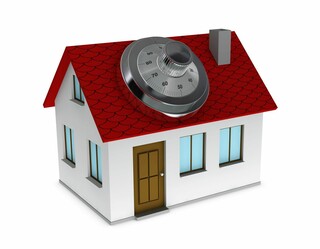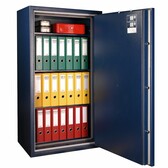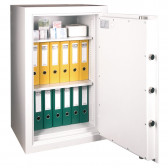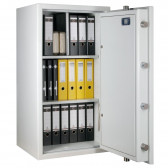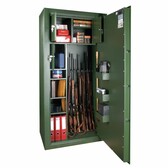A safe for home is a serious consideration. Now that you've decided that your home could use a safe, let's look at a few aspects of the buying process. A home safe is a piece of equipment that you are buying for years to come, its choice needs to be well thought out and planned, not only so that it meets your expectations, but also that it fits into your living space.
4 ways to place a safe in your house or flat
The location of the safe is one of the most important issues you need to work through to make sure everything works. A home safe can be placed in a number of locations, of which we have selected four of the most popular.
Dressing room
If you have a separate room in your house or flat for a wardrobe, this will probably be the first place you consider. It's no surprise – it's a very intimate room that you don't let random people into. As a rule, you'll have a lot of wardrobes and alcoves in there, into which you can easily incorporate a safe.
Office
Locating a safe in a desk in an office is a common choice for business people. In light of current data protection legislation, basically every entrepreneur is obliged to provide a safe storage place for this data. Compact fireproof safes are sized to fit easily into a desk or other office furniture.
Basement
Locating a safe in the basement has many advantages. The basement is a fairly secure, out-of-the-way place, allowing you to have free space, which allows you to expand your choice with larger models that have a higher resistance class. This is important if you need to store a larger number of files containing important documents.
Wall
Although many customers opt for wall safes for their concealment from burglars, it is important to remember that wall-mounted safes are a common choice when space is limited in a house or flat. The category of wall-mounted safes is quite limited, at most you will find a class I security, and there is no chance of fire resistance. However, if the purpose of the safe is to be reduced to storing weapons or small cash, then by all means such a product can be useful.
Check out more: Safe at home – where to hide it and what to look for when buying
A home safe – for whom will it work best?
The saying goes that everyone has something to hide. Indeed, it turns out that when you do an examination of conscience, you will discover that your home has entire binders of important documents, jewellery stashes, cash and, most importantly and most often overlooked, family heirlooms. Although a home safe is primarily associated with storing items of high value, it is the items of sentimental value, family photographs, letters, etc. that are the treasures whose loss will hurt you the most.
Your safe for home – what does a safe installation involve?
The assembly of a safe is done in the vast majority of the same way. The safe must be installed in a place where it can be placed directly on the floor. Please note that there must be no water or electrical installations running through the chosen location, and if you are in doubt about this, you will need to look for another location. The safe is mounted by drilling a hole in the floor, driving in a steel anchor (or chemical anchor) and, once the safe is positioned on it, tightening the bolt. Mounting in the wall is done analogously.
There are times when classic mounting cannot take place. There are options for placing the safe on a pedestal manufactured for a specific model. This is a steel structure mounted to the floor, to which the safe is drilled.
Is it worth anchoring large safes with a high weight?
The vast majority of safes used in private hands do not exceed a weight of 1000 kg, which means that the safe must be permanently anchored to a structural element of the building – floor or wall, or possibly both. This follows directly from the European standard EN 1143-1, according to which safes are certified. Next to the security class, the weight of the safe is the most important parameter of the device. The hard truth is that every home safe can be broken into, it's just a matter of time. This is why it is particularly important that burglars are unable to take the safe with them. Mounting the safe permanently to the floor or wall is not an element of additional security, but a procedure for proper installation.
Safes for home – what to look for when buying?
A safe for home is not an easy thing to do and there are several aspects that you should pay attention to. First of all, remember that you are customising your home safe to suit your own needs, you will be keeping valuables, cash, souvenirs and documents there.
A small safe at home
Therefore, avoid devices such as mini home safes or supermarket products that are safes in name only. A small home safe is bound to be light and handy, both for you and the thief, so if you are buying a safe for storing valuables, choose equipment that has a multi-walled body and door construction, the right weight and security rating, and fire resistance doesn't hurt. The more versatile a home safe is, the better for you.
A large safe at home
A large safe at home, on the other hand, allows you to store more in the long term. There is no denying that over the years you will grow more and more documents and valuables, and you may decide to use the safe to store weapons. In our experience this is a phenomenon that we see in the statistics: very many customers return after a few years to buy something bigger. And that's fine, a large safe is a heavy safe and therefore more difficult to carry out. However, you do need some space for such a product.
Choose an electronic lock
Although the standard method of locking a safe is a key lock, the electronic lock is by far the most common choice, and for good reason. A key lock may be cheaper, but it is less convenient and prone to the human factor. From a security point of view, there is little difference, but a keypad and code is a convenient, easy-to-use solution, especially if the safe is used by more than one person.
Which home safe to choose? Summary
There are different categories of safes and, for the novice customer, discerning the range can be a problem. A buying guide is no substitute for direct contact with a professional adviser, which we warmly encourage you to do. In brief, however, we can say that we recommend for home safes of at least class I according to EN 1143-1, fireproof for at least 60 minutes, equipped with an electronic lock and of a size that allows the storage of at least a few files. Hiding the safe in the wall does not make sense, so we recommend mounting it to the floor.
Read also: How to change the code in a safe? Overview of the most common locks
How do you secure your home against theft over the Christmas period?
